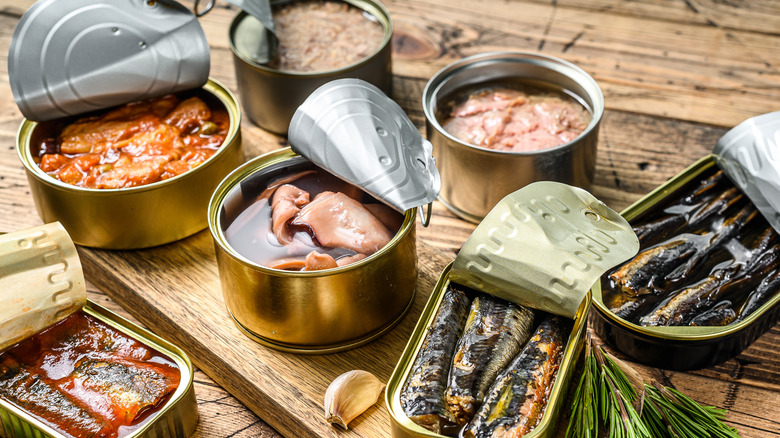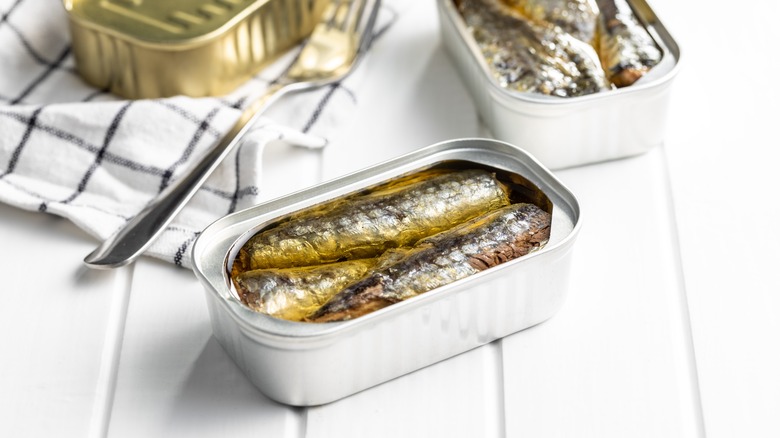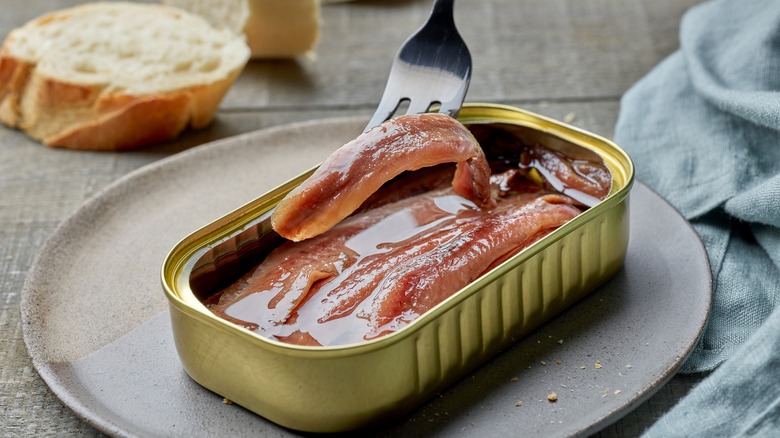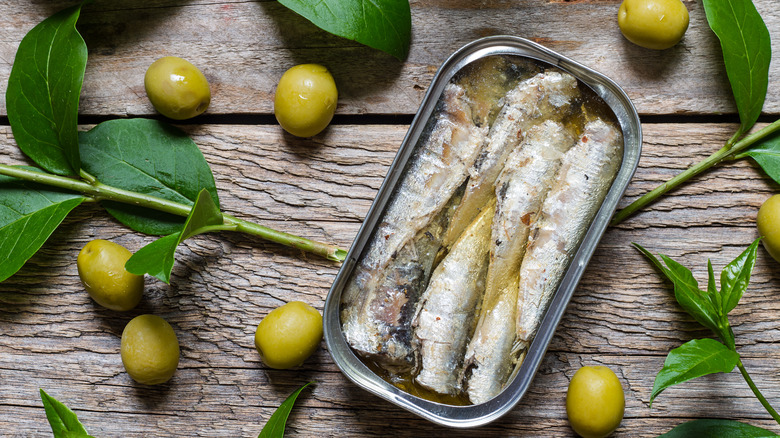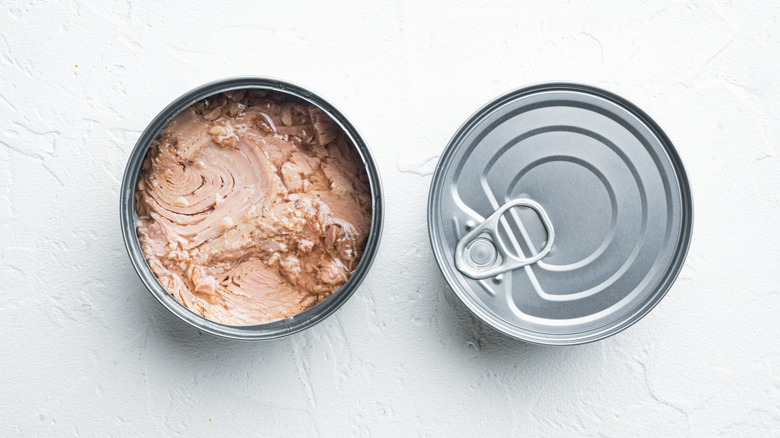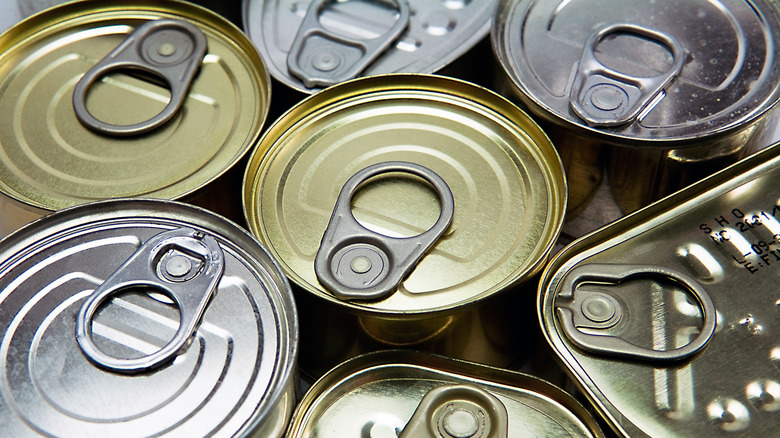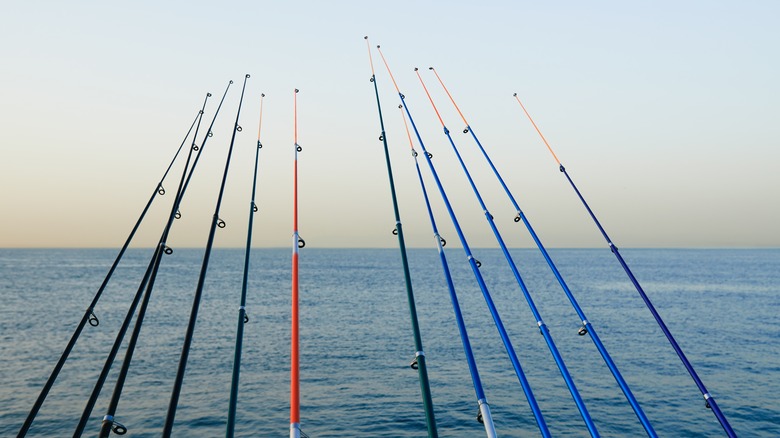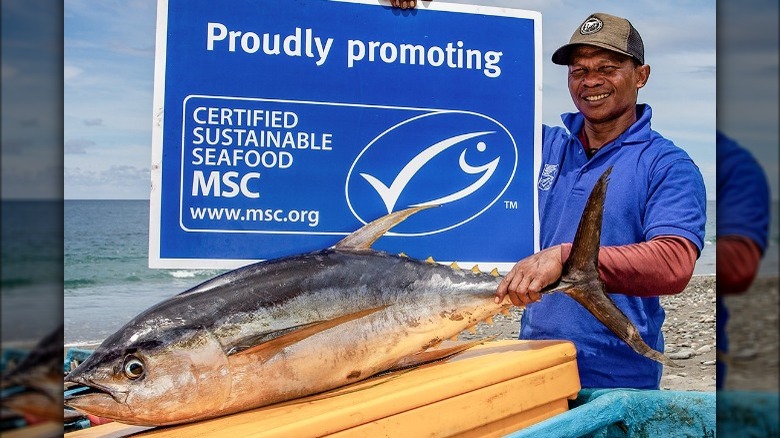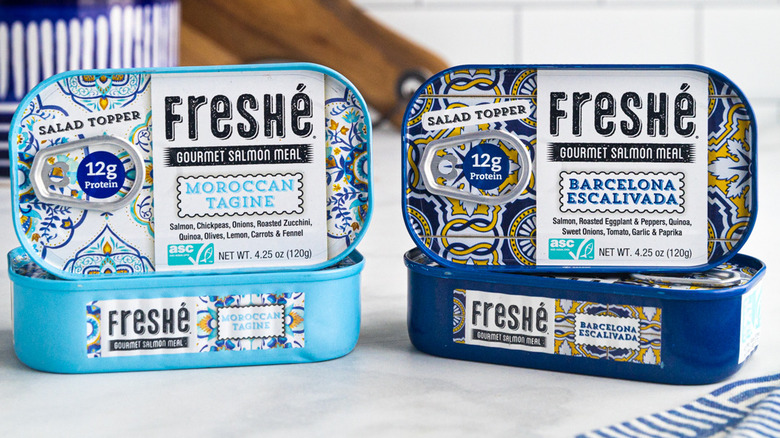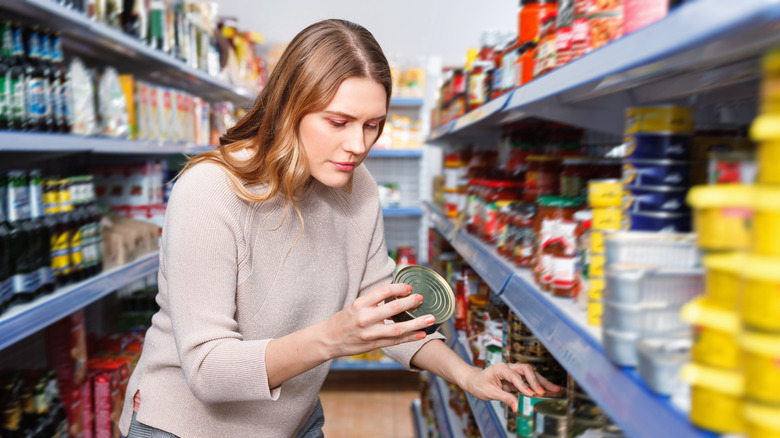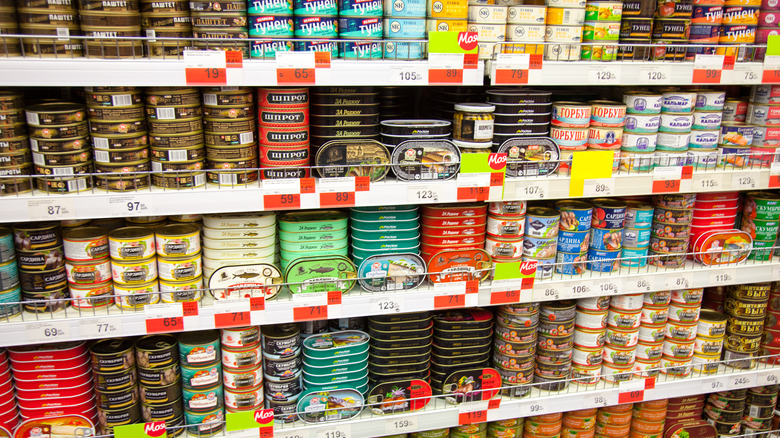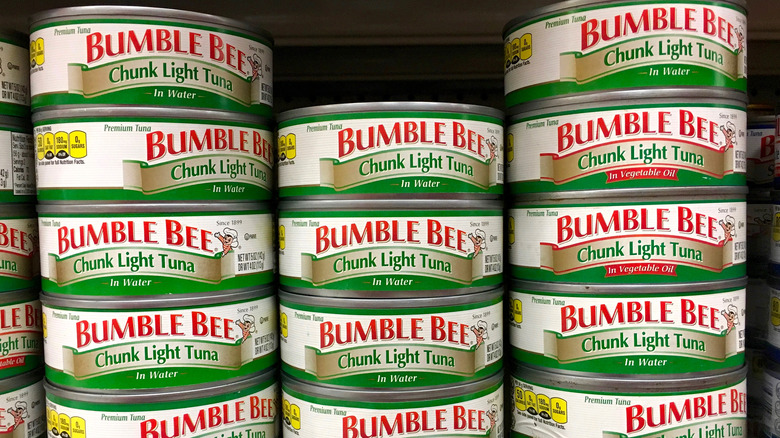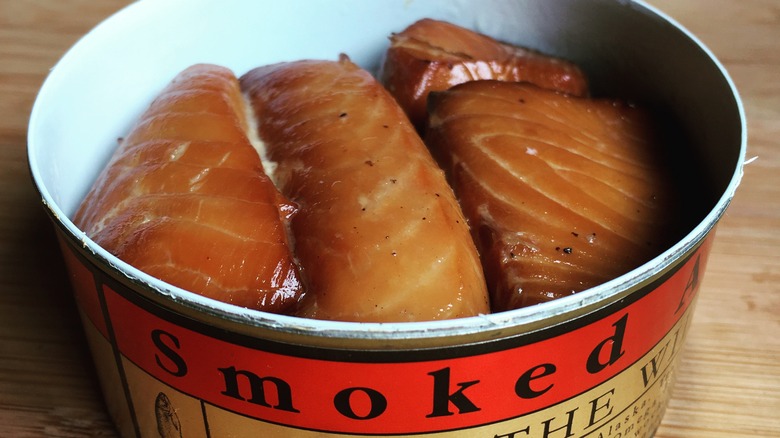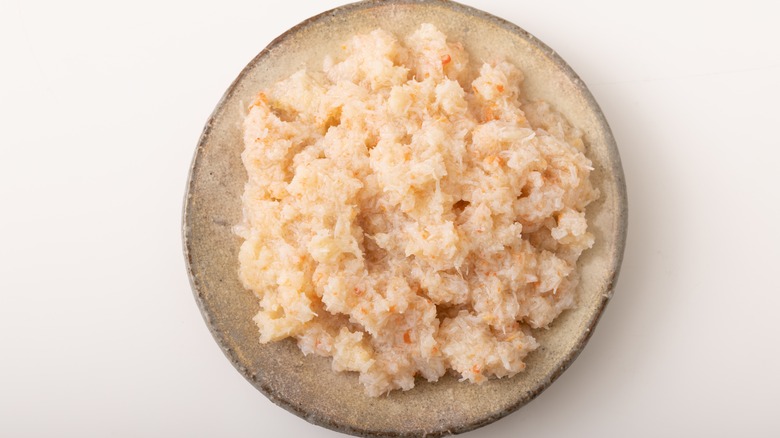14 Things To Look For When Buying Canned Fish
Canned fish doesn't always get the best rap. For many, it's the second choice when there isn't any decent fresh fish available. But that doesn't have to be the case. If you know what to look for, you can find some genuinely delicious and healthy canned fish that can be transformed into surprisingly gourmet dishes. A good can of fish preserves the flavor and texture of what's inside and doesn't over-rely on salt, preservatives, or questionable ingredients to increase shelf life.
But the labels can be vague at best and confusing at worst. What's the difference between chunk light and chunk white? Should you opt for sustainably caught or responsibly caught fish? How important is it to find a BPA-free can? What about mercury? Keep reading to demystify the confusing world of canned fish labels so you can find the safest, most sustainable, and best-tasting option at your grocery store.
1. Choose low-contaminant fish species
Canned fish labels don't tell you the exact levels of contamination, but nearly every species contains some mercury or polychlorinated biphenyls (PCBs) due to toxin build-up in the food chain (via Indiana Department of Environmental Management). According to the Environmental Protection Agency, high doses of both contaminants pose serious health risks, including cancer, learning disabilities, and vision loss. To limit the buildup of these toxins, there are some rules of thumb that can guide you.
For starters, choose fish at the bottom of the food chain where contamination levels tend to be lower. While bottom feeders consume small amounts of contaminated food sources like plankton or plants, predators eat fish that have already accumulated contamination from those plants and plankton, causing levels to climb faster (via Vermont Department of Environmental Conservation).
It's also best to avoid large, long-lived fish. Mercury and other contaminants build up over time, so bigger fish with longer lifespans will typically contain higher levels of toxins (via Sea To Table). Additionally, stay away from farmed fish that doesn't have an Aquaculture Stewardship Council (ASC) certification. Fisheries use antibiotics and pesticides to manage disease in overcrowded farms, which can leave residue in the fish you eat (via Beyond Pesticides). ASC certification restricts the use of these chemicals to some degree, so the risk of contamination is a little lower.
2. Check the sodium level
Canned fish can make for a quick and tasty lunch or appetizer, but some brands get an extra punch of flavor by loading up on salt. The American Heart Association notes that although your body needs some sodium to maintain stable fluid levels, too much can cause high blood pressure and, ultimately, heart disease.
Since the average American already consumes more than the recommended amount of sodium each day, as reported by the Centers for Disease Control, watching your intake is important. While the CDC recommends limiting sodium to 2,300 mg per day, a standard three-ounce can of tuna packed in oil contains over 350 milligrams of sodium. When you add bread and condiments to make a sandwich, it's easy to get the bulk of your daily sodium intake in a single meal without realizing just how much you've consumed.
Fortunately, many brands are starting to offer low-sodium alternatives for health-conscious consumers. Look for labels that advertise low-sodium content or no salt added. But before you take the advertising at its word, double-check the nutrition label to find the actual sodium content.
3. Opt for fish canned in oil
While fish canned in oil tends to have more sodium than fish canned in water, it also has more flavor and nutritional content. That's because oil preserves protein better than water. If you're eating canned fish primarily for the flavor or protein content, it might be worth taking the higher sodium option and finding other areas of your diet to cut sodium intake. Alternatively, you can just rinse the fish right before you eat it, as research shows that can remove up to 80% of the sodium content (via Journal of the American Dietetic Association).
In terms of flavor and texture, oil-packed fish also takes the gold. Oil helps fish retain its rich, flaky texture, whereas water-packed versions tend to be a bit drier. That's true whether or not you end up rinsing it before eating it — though you will lose the added flavor and texture of the oil if you run the fish under water.
4. Skip water-packed fish unless you're counting calories
As noted, fish canned in oil tends to pack more flavor, better texture, and more nutrients than its water-packed counterpart. Consequently, most cooks will prioritize oil-packed fish, but that doesn't mean there isn't a case for using fish canned in water.
If you're restricting calories, for example, water-packed fish is still tasty and comes at a fraction of the calorie count. While a 6.5-ounce can of oil-packed tuna has around 300 calories, a can of water-packed tuna of the same size only contains 150 calories. That means you could eat twice as much water-packed fish without adding any extra calories.
The drier, flakier texture also makes water-packed fish a good option for richer dishes where you want to combine other fats and flavors to shine alongside the fish. Similarly, if you're making fish cakes or appetizers that need a light and fluffy texture, water-packed fish is a great choice.
5. Check for allergens
If you have a food allergy, you're best not to take the front label of a package at its word. While a can of tuna in olive oil sounds pretty straightforward, manufacturers sometimes add preservatives or blend olive oil with other oils that could be made from a common food allergen. Some of the most common hidden allergens found in canned fish are a milk protein called casein and soybean oil (via the American Medical Association Journal of Ethics).
Another tricky product is canned imitation crab. To start, if you have a shellfish allergy, you need to avoid pretty much every brand of imitation crab out there because they typically use a small amount of crab extract to create the flavor (via Uptown Allergy & Asthma). Even if you can eat shellfish, imitation crab is a groundfish blend typically made with egg whites, corn starch, and other common food allergens.
If you really want to make allergy-safe crab cakes, try making your own surimi at home to skip the crab extract and swap any allergens with safer substitutes, like vegan egg whites instead of real eggs or potato starch instead of corn starch. Because imitation crab consists of ground fish meat, the texture will be similar even if doesn't have quite the same crab-like flavor.
6. BPA-free cans aren't necessarily better
When comparing canned fish products, you'll likely encounter many that advertise BPA-free materials. For decades, canned food was typically manufactured with an epoxy resin lining on the inside that contained bisphenol A (BPA), until research found that the toxic chemical was leaching into the food. After intense consumer pressure, U.S. manufacturers gradually found alternatives and today, about 98% of canned food is BPA-free (via Can Manufacturers Institute).
But there's a catch. While consumers are no longer being exposed to BPA, manufacturers rarely disclose the alternative coating they use. However, new research is demonstrating that some of the most common alternatives found in canned food — including acrylic resins, PVC, and polyesters — pose their own health hazards (via Environmental Working Group).
So, BPA-free doesn't quite mean toxin-free. According to Livestrong, if you're concerned about exposure to potentially harmful chemicals, your best bet is to opt for jarred fish rather than canned because glass doesn't require a protective coating.
Another perk of glass packaging is that manufacturers have to use low-temperature pasteurization techniques to prevent jars from breaking due to thermal shock (via Tiselab). That lower heat means the contents are going to be made up of larger, more tender chunks rather than small flakes.
7. Choose troll- or pole-caught fish
Even when a fish population isn't under threat of extinction, it can still end up being an unsustainable choice because the fishing method has other environmental consequences, like habitat destruction and bycatch (via National Oceanic and Atmospheric Administration). Of all the methods used, trolling lines or pole-and-line fishing are the two most sustainable options (via Seafood Watch).
Pole-and-line is similar to what hobby fishers use and consists of a line with a baited hook that catches a single fish. If the fish isn't the desired species, fishers can toss it back before it's severely injured or killed. Trolling lines are similar except that they can also move. Boats will typically throw several lines in the water simultaneously and tow them behind as they go. This method also makes it easy to quickly release unwanted species before they're harmed.
The fishing method mostly matters from a sustainability perspective, but some argue that it indirectly impacts flavor. The Global Seafood Alliance indicates that stress can trigger the release of lactic acid and break down muscle, meaning fish caught via harmful methods might have an inferior texture and flavor to those caught with more humane techniques.
While labels don't have to specify the fishing method, some brands voluntarily include it. If not, you can sometimes find it online if you research the brand. For example, Monterey Bay Aquarium's Seafood Watch website provides region-based consumer guides that include fishing method information for different seafood products.
8. Look for a Marine Stewardship Council label for wild-caught fish
The Marine Stewardship Council (MSC) provides the most rigorous third-party certification available right now for wild-caught fish. If you see the blue MSC check mark on the label, it means a product meets a wide range of sustainability criteria, including avoiding overfished or threatened species, minimizing ecosystem destruction, and not using certain harmful fishing methods (via MSC).
As useful as it is, there are some gaps in the MSC criteria that mean the canned fish you're eating may not necessarily be the most sustainable option. According to FoodPrint, one of the most glaring issues is that MSC doesn't restrict incidental bycatch that occurs when fishers accidentally catch species other than the specific ones they are fishing.
Another point of criticism is the MSC's lack of worker welfare requirements. While it strongly condemns the use of forced labor and child labor in fishing — a pervasive issue in the seafood industry — it does not restrict it. It also doesn't require fair wages or health and safety protections for workers.
Still, MSC is constantly reviewing and developing its standards and actively invites feedback and recommendations from the public. If you want to see those gaps closed, you can sign up to participate in their next round of consultations. In the meantime, an MSC label means that canned fish meets at least the minimum environmental and ethical standards, putting it a step above products that don't.
9. Look for an Aquaculture Stewardship Council label for farmed fish
The ASC label is the equivalent of the MSC for farmed fish. In fish farming, the waste produced by high-density concentrations of fish can pollute the surrounding ecosystem, creating "dead zones" (via Global Seafood Alliance). Moreover, antibiotics can end up destabilizing ocean ecosystems by disrupting the microbiome and harming human health by increasing the risk of drug-resistant pathogens (via Nature).
To obtain ASC certification, a producer must demonstrate that it doesn't use antibiotics or other drugs except to treat an actual disease. The certification also requires higher feed quality, sustainable techniques, and strict worker welfare standards — including no use of forced or child labor. However, it's still not perfect. For example, FoodPrint says that the ASC doesn't restrict all pesticides or chemicals found in fish farms. And its environmental and ecosystem welfare criteria allow farmers to continue certain hazardous practices.
Although the standards still have room for improvement, when it comes to farmed fish, a can with an ASC label is better than a can without. If you really want to make the most sustainable choice, your best bet is to search for the fish you're considering buying on Seafood Watch's recommendation database. Then, pick one of their "best choice" options. While Seafood Watch doesn't offer a certification, its recommendations are based on the most comprehensive and rigorous criteria available, beating out even MSC and ASC.
10. Be extra skeptical of self-claim eco labels
MSC and ASC aren't the only seafood certifications out there, but despite their faults, they are still the most rigorous. As a shopper, that means you should be extremely skeptical of any eco-label that isn't from those two organizations.
The most dubious eco-labels, though, are the self-claims brands make to present their canned fish as sustainable. Labels with vague phrases like "sustainably sourced" or "responsibly caught" aren't independently verified and could mean anything (via FoodPrint). Sustainable by what measure? Responsible in what sense?
You can do some extra digging online to find out if a company clarifies what its labeling means, but unless it also has those claims independently verified by a third party, they still don't hold much weight. Ultimately, if a canned fish is really as sustainable or ethical as it wants to portray itself, it would likely apply for MSC or ASC certification. If the certification is missing, it's not there for a reason.
11. Be wary of labels that don't specify species, source, or fishing methods
Alongside dubious self-claims, the conspicuous absence of information about the source, fishing method, or the ingredients used in the can's lining can be another red flag for shoppers. As mentioned, manufacturers typically don't have to disclose these details but many still volunteer the information so consumers can make an informed choice.
If a company is prioritizing sustainable, ethical, or low-contamination sourcing, it would also want to advertise that fact to help its product stand out from competitors. So if a label is missing a detail, shoppers can usually assume it's because the brand doesn't want you to know (via FoodPrint).
Of course, the space on a can of fish might not be large enough to fit every detail about the company's sourcing and manufacturing process, so you might have to go online to find in-depth information. However, a good label should include at least the following: an MSC or ASC label to signal that it meets minimal sustainability standards; an ingredient list that specifies the actual fish species; and whether the fish is wild caught or farmed.
12. When buying tuna, always choose skipjack
According to the World Bank, tuna isn't actually a single fish but an umbrella term including 61 different species, of which only 14 are real tuna. Of those, the top three species sold in cans are albacore, yellowfin, and skipjack.
From a conservation standpoint, skipjack is the eco-friendliest tuna to eat. The fast-growing, rapidly-reproducing species is categorized as being of "least concern" on the International Union for Conservation of Nature's (IUCN) Red List. Meanwhile, yellowfin tuna is listed as "near-threatened." While albacore can be a sustainable option, some populations are overfished. Since most cans don't tell you exactly where the fish was caught, you're taking a risk anytime you pick albacore.
In addition to being among the least-threatened species of tuna, skipjack also passes the low contamination test; it's smaller than other tuna and typically only lives for about three or four years. According to the U.S. Food & Drug Administration, skipjack has less than half the mercury content of albacore and yellowfin.
Unfortunately, loose labeling requirements can make it hard to know what's actually in a can. As long as the fish is one of the species classified as "true tuna," manufacturers aren't required to specify the exact species (via Planet Tuna). With that said, cans labeled "light," such as chunk light or light tuna, are most likely skipjack — unless they specify "solid light" which is usually bigeye or yellowfin (via FoodPrint).
13. Avoid Atlantic salmon
Atlantic salmon is a species that was driven to near extinction from overfishing and is now found almost exclusively in farms. So, unless that can of Atlantic salmon is also ASC-certified, your best bet is to put it back on the shelf to avoid pesticides and other contaminants in your meal (via Good Housekeeping).
Instead, opt for wild-caught salmon, especially Alaskan salmon which is one of the most sustainably managed fisheries in the world. Before you toss that Alaskan salmon in your cart, check the label to find out where the can itself comes from. If it says anything other than "product of the United States," that means the fish may have been caught in Alaska but it was shipped overseas for processing and then shipped back to be sold.
Not only does all that international shipping dial up the carbon footprint of your canned salmon, but it can also be a red flag that the company is trying to exploit looser labor laws in other countries. According to The Guardian, in the seafood industry, that can mean forced labor was used.
14. Make sure to choose US-caught blue crab
For canned crab, Seafood Watch says that the most sustainable and ethical pick is U.S.-caught blue crab, especially if it's from Alabama, Delaware, New Jersey, or Maryland. While Seafood Watch provides some other good alternatives, blue crab from these regions is the most sustainable species you can buy.
Beyond sustainability concerns, you'll want to pick a can labeled "jumbo lump" or "lump" to get the best flavor and texture. Anything else will be made up of flakier, smaller pieces of less flavorful crab meat. That might be fine if you're using it to make crab cakes or blending it into a bisque. But in a salad or on top of pasta, you want big, juicy pieces of crab meat.
Finally, for the freshest possible canned crab, head to the cold section of your grocery store and look for a can that's refrigerated, as this means it wasn't pasteurized as heavily so you'll get a fresher taste.
